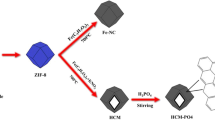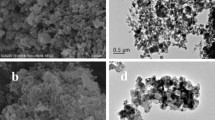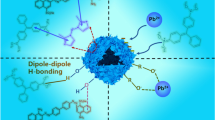Abstract
Recently, highly porous metal–organic frameworks (MOFs), with excellent porosity and abundant functional groups, have represented a new addition to the area of capturing uranium ion pollutants. To achieve high adsorption capacity and removal efficiency of uranium, it is significant to modify the morphology of MOF-based adsorbents. In this contribution, two hollow structured ZIF-8 adsorbents were used for the adsorptive separation of uranium from aqueous solution. Both of them showed faster adsorption rate and larger adsorption capacity than pristine ZIF-8, providing the prospect of hollow MOF materials to the application of uranium extraction.






Similar content being viewed by others
References
Yuan YH, Liu TT, Xiao JX, Yu QH, Feng LJ, Niu BY, Feng SW, Zhang JC, Wang N (2020) DNA nano-pocket for ultra-selective uranyl extraction from seawater. Nat Commun 11(1):5708. https://doi.org/10.1038/s41467-020-19419-z
Ahmad M, Yang K, Li LX, Fan YH, Shah T, Zhang QY, Zhang BL (2020) Modified tubular carbon nanofibers for adsorption of uranium(VI) from water. ACS Appl Nano Mater 3(7):6394–6405. https://doi.org/10.1021/acsanm.0c00837
Zhao R, Shi XY, Ma TT, Rong HZ, Wang ZY, Cui FC, Zhu GS, Wang C (2021) Constructing mesoporous adsorption channels and MOF–polymer interfaces in electrospun composite fibers for effective removal of emerging organic contaminants. ACS Appl Mater Interfaces 13(1):755–764. https://doi.org/10.1021/acsami.0c20404
Feng ML, Sarma D, Qi XH, Du KZ, Huang XY, Kanatzidis MG (2016) Efficient removal and recovery of uranium by a layered organic-inorganic hybrid thiostannate. J Am Chem Soc 138(38):12578–12585. https://doi.org/10.1021/jacs.6b07351
Dang DH, Novotnik B, Wang W, Georg RB, Evans RD (2016) Uranium isotope fractionation during adsorption, (Co)precipitation, and biotic reduction. Environ Sci Technol 50(23):12695–12704. https://doi.org/10.1021/acs.est.6b01459
Chi FT, Zhang S, Wen J, Xiong J, Hu S (2018) Highly efficient recovery of uranium from seawater using an electrochemical approach. Ind Eng Chem Res 57(23):8078–8084. https://doi.org/10.1021/acs.iecr.8b01063
Huang Z, Dong H, Yang N, Li H, He NN, Lu XR, Wen J, Wang XL (2020) Bifunctional phosphorylcholine-modified adsorbent with enhanced selectivity and antibacterial property for recovering uranium from seawater. ACS Appl Mater Interfaces 12(14):16959–16968. https://doi.org/10.1021/acsami.0c01843
Ma SL, Huang L, Ma LJ, Shim Y, Islam SM, Wang PL, Zhao LD, Wang SC, Sun GB, Yang XJ, Kanatzidis MG (2015) Efficient uranium capture by polysulfide/layered double hydroxide composites. J Am Chem Soc 137(10):3670–3677. https://doi.org/10.1021/jacs.5b00762
Sun Q, Aguila B, Earl LD, Abney CW, Wojtas L, Thallapally PK, Ma SQ (2018) Covalent organic frameworks as a decorating platform for utilization and affinity enhancement of chelating sites for radionuclide sequestration. Adv Mater 30(20):e1705479. https://doi.org/10.1002/adma.201705479
Das S, Oyola Y, Mayes RT, Janke CJ, Kuo LJ, Gill G, Wood JR, Dai S (2015) Extracting uranium from seawater: promising AF series adsorbents. Ind Eng Chem Res 55(15):4110–4117. https://doi.org/10.1021/acs.iecr.5b03136
Kou SZ, Yang ZG, Sun F (2017) Protein hydrogel microbeads for selective uranium mining from seawater. ACS Appl Mater Interfaces 9(3):2035–2039. https://doi.org/10.1021/acsami.6b15968
Karmakar R, Sen K (2019) Role of biomolecules in selective extraction of U(VI) using an aqueous biphasic system. J Radioanal Nucl Chem 322(1):57–66. https://doi.org/10.1007/s10967-019-06494-w
Zhang N, Xing YH, Bai FY (2020) Triazine functionalized porous three-dimensional uranyl-organic framework: extraction of Uranium(VI) and adsorption of cationic dyes in aqueous solution. Cryst Growth Des 20(3):1838–1848. https://doi.org/10.1021/acs.cgd.9b01553
Sun YX, Huang HL, Vardhan H, Aguila B, Zhong CL, Perman JA, Al-Enizi AM, Nafady A, Ma SQ (2018) Facile approach to graft ionic liquid into MOF for improving the efficiency of CO2 chemical fixation. ACS Appl Mater Interfaces 10(32):27124–27130. https://doi.org/10.1021/acsami.8b08914
Zhao B, Yuan LY, Wang Y, Duan T, Shi WQ (2021) Carboxylated UiO-66 tailored for U(VI) and Eu(III) trapping: from batch adsorption to dynamic column separation. ACS Appl Mater Interfaces. https://doi.org/10.1021/acsami.1c00364
Luo SH, Zeng ZT, Zeng GM, Liu ZF, Xiao R, Chen M, Tang L, Tang WW, Lai C, Cheng M, Shao BB, Liang QH, Wang H, Jiang DN (2019) Metal organic frameworks as robust host of palladium nanoparticles in heterogeneous catalysis: synthesis, application, and prospect. ACS Appl Mater Interfaces 11(36):32579–32598. https://doi.org/10.1021/acsami.9b11990
Li J, Jiang LY, Chen S, Kirchon A, Li B, Li YS, Zhou HC (2019) Metal-organic framework containing planar metal-binding sites: efficiently and cost-effectively enhancing the kinetic separation of C2H2/C2H4. J Am Chem Soc 141(9):3807–3811. https://doi.org/10.1021/jacs.8b13463
Song Y, Wei GY, Kopeć M, Rao LF, Zhang ZC, Gottlieb E, Wang ZY, Yuan R, Ye G, Wang JC, Kowalewski T, Matyjaszewski K (2018) Copolymer-templated synthesis of nitrogen-doped mesoporous carbons for enhanced adsorption of hexavalent chromium and uranium. ACS Appl Nano Mater 1(6):2536–2543. https://doi.org/10.1021/acsanm.8b00103
Chen XR, Tong RL, Shi ZQ, Yang B, Liu H, Ding SP, Wang X, Lei QF, Wu J, Fang WJ (2018) MOF Nanoparticles with encapsulated autophagy inhibitor in controlled drug delivery system for antitumor. ACS Appl Mater Interfaces 10(3):2328–2337. https://doi.org/10.1021/acsami.7b16522
Xu L, Zhang D, Ma FY, Zhang JR, Khayambashi A, Cai YW, Chen LH, Xiao CL, Wang SA (2019) Nano-MOF+ technique for efficient uranyl remediation. ACS Appl Mater Interfaces 11(24):21619–21626. https://doi.org/10.1021/acsami.9b06068
Zhang JC, Zhang HS, Liu Q, Song DL, Li RM, Liu PL, Wang J (2019) Diaminomaleonitrile functionalized double-shelled hollow MIL-101 (Cr) for selective removal of uranium from simulated seawater. Chem Eng J 368:951–958. https://doi.org/10.1016/j.cej.2019.02.096
Lee I, Choi S, Lee HJ, Oh M (2015) Hollow metal-organic framework microparticles assembled via a self-templated formation mechanism. Cryst Growth Des 15(11):5169–5173. https://doi.org/10.1021/acs.cgd.5b00919
Dou WX, Yang WT, Zhao XJ, Pan QH (2019) Hollow cobalt sulfide for highly efficient uranium adsorption from aqueous solutions. Inorg Chem Front 6(11):3230–3236. https://doi.org/10.1039/c9qi00737g
Zhang HF, Zhao M, Yang Y, Lin YS (2019) Hydrolysis and condensation of ZIF-8 in water. Microporous Mesoporous Mater. https://doi.org/10.1016/j.micromeso.2019.109568
Wang CH, Zheng T, Luo R, Liu C, Zhang M, Li JS, Sun XY, Shen JY, Han WQ, Wang LJ (2018) In situ growth of ZIF-8 on PAN fibrous filters for highly efficient U(VI) removal. ACS Appl Mater Interfaces 10(28):24164–24171. https://doi.org/10.1021/acsami.8b07826
Liu LJ, Yang WT, Gu DX, Zhao XJ, Pan QH (2019) In situ preparation of Chitosan/ZIF-8 composite beads for highly efficient removal of U(VI). Front Chem 7:607. https://doi.org/10.3389/fchem.2019.00607
Yang YF, Wang FW, Yang QH, Hu YL, Yan H, Chen YZ, Liu HR, Zhang GQ, Lu JL, Jiang HL, Xu HX (2014) Hollow metal-organic framework nanospheres via emulsion-based interfacial synthesis and their application in size-selective catalysis. ACS Appl Mater Interfaces 6(20):18163–18171. https://doi.org/10.1021/am505145d
Cheng XX, Jiang ZY, Cheng XP, Yang H, Tang L, Liu GH, Wang MR, Wu H, Pan FS, Cao XZ (2018) Water-selective permeation in hybrid membrane incorporating multi-functional hollow ZIF-8 nanospheres. J Membr Sci 555:146–156. https://doi.org/10.1016/j.memsci.2018.03.024
Yang WT, Pan QH, Song SY, Zhang HJ (2019) Metal–organic framework-based materials for the recovery of uranium from aqueous solutions. Inorg Chem Front 6(8):1924–1937. https://doi.org/10.1039/c9qi00386j
Bai ZQ, Yuan LY, Zhu L, Liu ZR, Chu SQ, Zheng LR, Zhang J, Chai ZF, Shi WQ (2015) Introduction of amino groups into acid-resistant MOFs for enhanced U(VI) sorption. J Mater Chem A 3(2):525–534. https://doi.org/10.1039/C4TA04878D
Liu R, Zhang W, Chen YT, Wang YS (2020) Uranium (VI) adsorption by copper and copper/iron bimetallic central MOFs. Colloids Surf, A. https://doi.org/10.1016/j.colsurfa.2019.124334
Luo BC, Yuan LY, Chai ZF, Shi WQ, Tang Q (2016) U(VI) capture from aqueous solution by highly porous and stable MOFs: UiO-66 and its amine derivative. J Radioanal Nucl Chem 307(1):269–276. https://doi.org/10.1007/s10967-015-4108-3
Wu YH, Li BY, Wang XX, Yu SJ, Pang HW, Liu Y, Liu XY, Wang XK (2019) Magnetic metal-organic frameworks (Fe3O4@ZIF-8) composites for U(VI) and Eu(III) elimination: simultaneously achieve favorable stability and functionality. Chem Eng J. https://doi.org/10.1016/j.cej.2019.122105
Yang PP, Liu Q, Liu JY, Zhang HS, Li ZS, Li RM, Liu LH, Wang J (2017) Interfacial growth of a metal–organic framework (UiO-66) on functionalized graphene oxide (GO) as a suitable seawater adsorbent for extraction of uranium(VI). J Mater Chem A 5(34):17933–17942. https://doi.org/10.1039/c6ta10022h
Acknowledgements
Financial support from the Natural Science Foundation of Hainan Province (2019RC005), the National Natural Science Foundation of China (22061014 and 21761010), Haikou Science and Technology Project (2020-033) and Hainan University start-up fund (KYQD(ZR)1806) is greatly acknowledged.
Author information
Authors and Affiliations
Corresponding author
Additional information
Publisher's Note
Springer Nature remains neutral with regard to jurisdictional claims in published maps and institutional affiliations.
Supplementary Information
Below is the link to the electronic supplementary material.
Rights and permissions
About this article
Cite this article
Ma, Y., Dou, W., Yang, W. et al. Enhanced uranium extraction from aqueous solution using hollow ZIF-8. J Radioanal Nucl Chem 329, 1011–1017 (2021). https://doi.org/10.1007/s10967-021-07848-z
Received:
Accepted:
Published:
Issue Date:
DOI: https://doi.org/10.1007/s10967-021-07848-z




